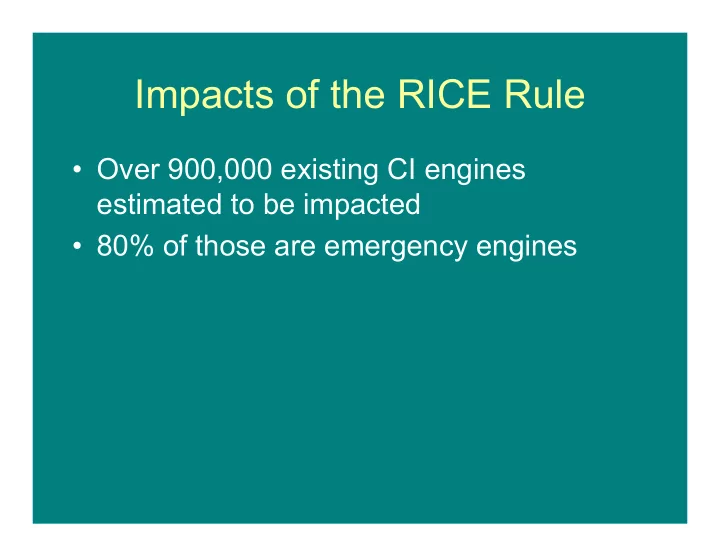

Impacts of the RICE Rule • Over 900,000 existing CI engines estimated to be impacted • 80% of those are emergency engines
Emission Reductions for 2013 (Estimated) VOC (27,000) 30,000 25,000 CO 20,000 (14,000) Reductions, 15,000 tons 10,000 PM HAP (2,800) (1,010) 5,000 0 1 Pollutants
Estimated Control Costs • For the year 2013: –Capital costs: $744 million –Annual costs: $373 million
Estimated Annual Benefits (based on PM 2.5 & precursor reductions) • ~ 110 - 270 fewer premature deaths • Dozens fewer – Hospital/ER visits – Cases of severe health effects (e.g., chronic bronchitis, heart attacks) • Thousands fewer minor respiratory symptoms • These benefits ≈ $940M to $2.1B annually
Emergency Engine Requirements • No limits on hours of operation for emergency service • Maintenance checks & readiness testing limited to 100 hrs/yr
Emergency Engine Requirements • 50 hrs/yr allowed for non-emergencies, but: – Counts as part of the 100 hr/yr maintenance & testing limit – Not for peak shaving, or generating income – Up to 15 of the 50 hrs/yr can be used for demand response in emergency situations (e.g., imminent blackout)
RICE = Reciprocating Internal Combustion Engines • There are two types of RICE: – CI = Compression Ignition (diesel) – SI = Spark Ignition (gas-fired) • Stationary version of car/truck engines • Used to drive compressors, pumps, electric generators & other equipment
Examples of RICE
Examples
Examples
Examples (soundproofed generator)
RICE NESHAP: 2004 AREA SOURCES MAJOR SOURCES NEW EXISTING NEW EXISTING > 500 HP NEW EXISTING NEW EXISTING < 500 HP Covered engines > 500 HP located at major sources
RICE NESHAP: 2008 AREA SOURCES MAJOR SOURCES NEW EXISTING NEW EXISTING > 500 HP NEW EXISTING NEW EXISTING < 500 HP Added new engines ≤ 500 HP located at major sources, plus all new engines at area sources
This newest rule covers • Existing engines: – < 500 HP at major sources – Of any size at area sources – Non-emergency engines > 500 HP at major sources (due to a consent decree)
Just to clarify . . . • Proposed rule (March 5, 2009) covered both CI & SI engines • Final rule issued in two parts: – CI engines: covered by rule we’re discussing today – SI engines: covered by rule to be signed August 10, 2010
Standards and Requirements: Three Groups • Non-emergency engines > 300 HP • Non-emergency engines 100 - 300 HP at major sources • Engines that are – < 100 HP at major sources – < 300 HP at area sources – All emergency engines (major / area sources)
Non-emergency engines > 300 HP: Emission Standards • Numerical CO emission limits – based on oxidation catalyst controls • Operating limitations for engines >500 HP – Catalyst pressure drop & inlet temperature • Ultra-low sulfur diesel (15 ppm S content) – if displacement <30 liters/cylinder • Crankcase emission control requirements
Non-emergency Engines > 300 HP Performance Testing • Initial performance test to show compliance • Initial test + subsequent testing every 8,760 hours of operation or 3 years for engines >500 HP
Non-emergency engines > 300 HP Monitoring & O/M Requirements • Operate/maintain crankcase controls per manufacturer’s instructions • For engines > 500 HP: – Continuous monitoring of catalyst inlet temperature – Monthly catalyst pressure drop checks
Non-emergency Engines 100 - 300 HP at Major Sources: • Emission Standards: numerical CO emission limits • Initial performance test required
< 100 HP @ Major Source, ≤ 300 HP @ Area Source, & All Emergency Engines • At major sources, work practice standards for: – Engines < 100 HP – Emergency engines • At area sources, management practice standards for: – Engines ≤ 300 HP – Emergency engines
What Are Work/Management Practices? • Change oil/filter, inspect air cleaner, hoses & belts on prescribed schedule • Operate/maintain engine & control device per mfr’s instructions or owner-developed maintenance plan • May use oil analysis program instead of prescribed oil change frequency • Emergency engines must keep records of hrs of operation & install hour meter
Recordkeeping & Reporting for Non-emergency Engines* • Submit: – Semi-annual compliance report – Initial notification – Notification of performance test – Notification of compliance • Keep records of maintenance * For engines ≥ 100 HP at major sources and >300 HP at area sources
Recordkeeping & Reporting • For emergency engines: – Record hours of operation – Keep maintenance records – No notifications required • If <100 HP at major source / ≤ 300 HP at area source: – Keep records of maintenance
Emergency Engines at Residential, Institutional, or Commerical Area Sources • Guidance for determining if a facility is one of these types of sources coming soon • Engine must meet definition of an emergency engine
Startup, Shutdown, & Malfunction Requirements • Initially, compliance was not required in such circumstances • Dec 2008 D.C. Circuit Court vacated exemption in General Provisions
Startup, Shutdown, & Malfunction: Response to Court Decision • Emission standards apply during shutdowns & malfunctions • Startup & idling time must be kept to 30 minutes or less • Also applies to engines covered by 2004 and 2008 RICE rules • Removed requirement for S/S/M plan
Key Dates: • Compliance date: May 3, 2013 • Existing sources must comply with startup/shutdown/malfunction requirements as of May 3, 2010
Implementation Materials • Go to http://www.epa.gov/ttn/atw/rice/ricepg.html – Sample notification available now – Flow charts & compliance requirement summaries coming this summer
REMEMBER . . . • Final rule on spark ignition engines to be signed 8/10/10
Recommend
More recommend